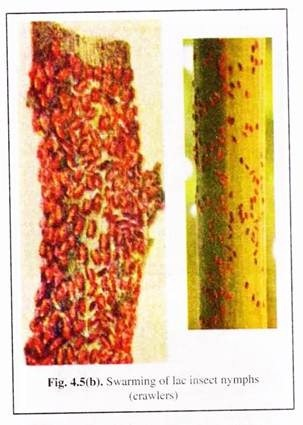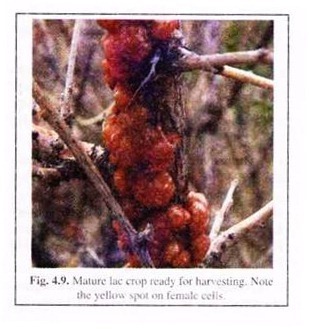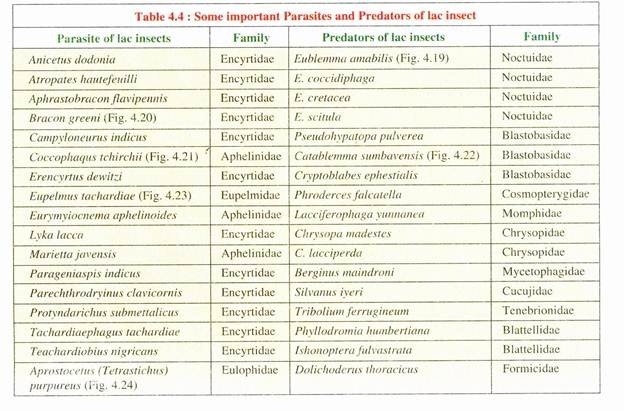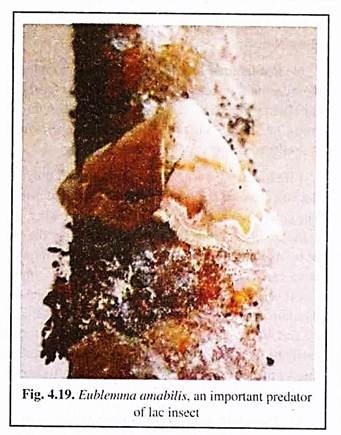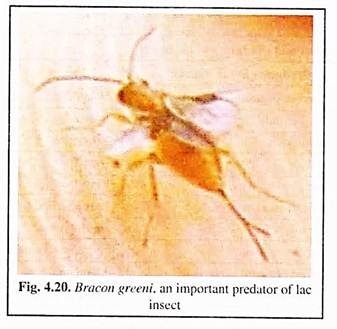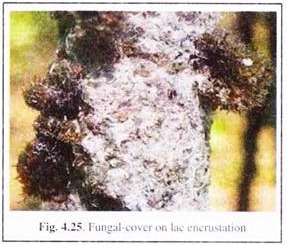In this article we will discuss about Lac Insects:- 1. Introduction to Lac Insects 2. Meaning of Lac Insect 3. Life Cycle 4. Taxonomy 5. Preparation of Feeding Ground for Lac Insects 6. Enemies of Lac Insects and their Control 7. Microbial Flora Associated with Lac Insects.
Introduction to Lac Insects:
Two strains of the lac insects are recognised in India, RANGEENI and KUSMI. The lac insects that thrive on the host plant Kusum is referred to as Kusmi whereas the Rangeeni strain generally grows on host plants other than Kusum. Each strain completes its life cycle twice a year but the seasons of maturity differ considerably.
There are four lac crops in a year that are named after the Hindi months (Table 4.2). Lac insects under the genus Kerria are generally bi-voltine with two broods in a year. But few species like K. lacca mysorensis (host plant-Sal), and K. sharda (host plant-Kusum) are tri-voltine having three broods in a year. Again, species belonging to the genus Paratachardia (host plants-Tea, Sandal, etc.,) are all univoltine.
Meaning of Lac Insect:
The lac insect is a minute, crawling, scaly insect with suctorial proboscis through which it sucks phloem sap of the host plant twigs. During growth, the insects secrete resinous lac from their body that gradually encases the body of the insect totally in a structure referred to as ‘CELL’ (Fig. 4.1).
Life Cycle of Lac Insect:
The life cycle of lac insect is completed within 6 months and it consists of stages like adult, egg and nymph instars (Fig. 4.2).
Adults:
ADVERTISEMENTS:
(i) Female:
The female lac insect has a pyriform body measuring about 4-5 mm in length (Fig. 4.3a & 4.3b). The body is indistinctly divided into head, thorax and abdomen. Head bears a pair of degenerated antennae. Eyes are absent. Mouthparts are of piercing and sucking type. Posterior to mouth lie a pair of spiracles which ensures smooth breathing of the insect during lac secretion.
Thorax has degenerated legs and lack wings. At the posterior part of the body, a triangular area – the anal tubercle encircling some setae is present. Near to it are present 2 branchial openings and one small chitinous spine called dorsal spine.
ADVERTISEMENTS:
(ii) Male:
The adult male is red in colour and smaller in size than the female insect. The length is about 1.2-1.5 mm. Head bears reduced eyes and ten segmented antennae. Mouth parts are similar to that of the females. Thorax has 3 pairs of legs.
The male lac insect may be either winged with one pair of hyaline wing on its thorax or wingless (apterous) [Fig. 4.4 and 4.2(f)]. The eight-segmented abdomen ends into a short chitinous prominent sheath containing penis. A pair of white elongated caudal seta or filament is present on either side of this sheath.
Egg:
The female lac insect is ovoviviparous in nature. So the laid eggs contain fully developed embryos within it. About 300-1000 such eggs are laid in the chambers (cell) in which the female remains encased. The egg laying period may last from 7 to 10 days. The eggs hatch within few hours of laying. But egg laying ceases if the temperature falls below 17°C in summer and 15°C in winter.
Nymphs:
Following hatching, the first instar nymph (Fig. 4.2a) stays within the cell for a brief period. Then the crimson red coloured nymphs, referred to as ‘crawlers’, come out of the cell in search of suitable host plant branch for settlement. The emergence of lac insect nymphs in huge number is commonly called swarming (Figs. 4.5a&b) that continues for several weeks.
Boat-shaped nymphs are very small in size (0.5 mm) and divisible into head, thorax and abdomen. Head bears antennae, ocelli and mouth. Thorax has 3 segments, each with one pair of leg and caudal setae are found at the end of abdomen.
On reaching soft succulent twigs, the nymphs settle down close together and start to suck phloem sap through their suctorial proboscis. After one day or so of settling, the nymphs start secreting lac from the hypodermal glands lying under their cuticle keeping open their mouthparts, breathing spiracles and anus. The secreted semisolid lac hardens on exposure to air and the nymph gets fully covered by the lac encasement, called as lac cell (Fig. 4.1).
Metamorphosis:
Within the cell, the nymphs moult thrice before reaching maturity. During first moult both male and female nymphs lose their appendages, legs and eyes. Following this moult, dimorphism appears in their cells. Inside the male cells, the male nymph casts off their second and third moults and matures into adults.
On maturity, the males lose their proboscis and develop antennae, legs and a pair of wings. The male brood cell is slipper- shaped (Fig. 4.2d). It bears a pair of branchial pores on the anterior side and a single large circular pore on the posterior side. The posterior hole remains covered by a round trap door or operculum through which adult males emerge.
The female brood cell is larger, globular in shape that remains fixed to the twig. The female cell also has a pair of branchial pore and a single round anal tubular opening through which protrudes waxy white filaments (it indicates that the insect inside the cell is alive and healthy).
These filaments also prevent the blocking of the pore during excess secretion of lac. Following second and third moulting, the females retain only mouthparts but fail to develop any wings, eyes or appendages. While developing into adult, the female becomes immobile and large in size to accommodate huge number of eggs.
During development, the females continuously secrete resin at a faster rate that coalesces around its body. After 14 weeks, the females shrink in size allowing light to pass into the cell (Fig. 4.1).
Mating:
Following emergence, the winged males walk over the immobile females and fertilize their eggs. The males die soon after copulation. A male has life of 62-92 hours.
Egg laying:
About the time of egg laying, two yellow spots appear at the rear end of the female cell which gradually enlarge and become orange in colour (Fig. 4.9). At this time, the females contract at one end of the cell and thus vacates a space, called ‘ovisac’, inside the cell.
Then the anal tubercle is drawn in the ovisac and the females start oviposit large number of eggs in the ovisac. The ovisac looks like orange due to presence of crimson lac dye which indicates the time of egg hatching.
Following hatching the nymphs emerge and the whole process begins all over again. After one cycle has been completed, and around the time when the next generation begins to emerge, the resin encrusted branches are harvested. From each crop, some encrusted twigs are retained for inoculation to the new host plants.
Parthenogenesis: In the life history of lac insect, parthenogenesis is known to occur when unfertilised eggs are directly hatched into nymphs. It is common in Kartiki crop of Rangeeni Strain.
Taxonomy of Lac Insect:
(After E.E.Ruppert and R.D. Barnes, 1994)
Phylum: Arthropoda;
Sub-phylum: Uniramia;
Class: Hexapoda/lnsecta; Subclass: Ectognatha
Scientific name: Kerria (Tachardia) lacca
The first scientific account about lac insect was given by J. Kerr in 1782, published in Philosophical Transaction of Royal Society of London. The first scientific name given to it was Tachardia lacca after the name of French Missionary Father Tachardia.
Later it was changed to Kerria lacca. Out of nine genera and 87 species of lac insects reported from the world, two genera and 19 species are found in India. Of these 19 species, only K. lacca is exploited for commercial production of lac. However, K. chinensis in northeastern states and K. sharcla in coastal regions of Orissa and West Bengal are also cultivated to certain extent.
Preparation of Feeding Ground for Lac Insects:
To get good quality lac through cultivation, it is necessary to ensure proper type of feeding ground to the lac insects. The insects need to be provided with succulent shoots, as it cannot drive its slender proboscis through thick bark. For getting a good number of requisite succulent shoots, the most important method is pruning.
Pruning:
Pruning means cutting away old, weak and diseased twigs from the host plants. It is done in January or June. It is very important for cultivation as it induces the host plants to throw out new succulent twigs. Pruning should be done with a sharp instrument to give a short and neat cut.
If trees are old and have lost their capacity to produce vigorous shoots of new flush, heavier pruning is carried out to produce the new wood at the expense of the old. Such operation will bring the tree to a better shape, so that subsequent pruning will give the desired flush. Proper pruning should result in a good shape and give plenty of chances for the development of new shoots.
Objectives of Pruning:
(1) To ensure new, good, healthy and succulent shoots.
(2) To ensure availability of large number of shoots (larger area for lac insect settlement).
(3) To provide rest to host plant for maintaining its vigour.
(4) To remove dead, diseased and broken branches.
Types of Pruning in Lac Host Plants:
Two types of pruning have been recommended for lac culture.
(i) Apical/ light pruning:
Branches less than 2.5 cm diameter should be cut from base and branches more than 2.5 cm diameter should be sharply cut leaving a stump of 30-45 cm from the base. Diseased and dead portion of branches should be removed completely. Light pruning is recommended for slow growing conventional host tree species like Palas, Kusum and Ber.
(ii) Basal / heavy pruning:
Branches having less than 7 cm thickness should be removed from the base, whereas thicker branches should be cut at a place where it has a diameter of 7 cm. In quick growing bushy host, pruning should be done at a height of 10-15 cm from the ground level, e.g., Flemingia macrophylla, F. semialata.
Pruning time:
After several years of experiment done at Indian Lac Research Institute (presently I.I.N.R.G.). Ranchi, Jharkhand, it has been found that the best results are obtained by pruning in February for raising the Kartiki crop and in April for raising the Baisakhi crop of Rangeeni for host plants Ber and Palas. Pruning in these months will give shoots of four and six months old respectively, for the lac larvae to feed on.
In case of Kusum, pruning is best done in the month of June-July and January- February. These months coincide with those in which the crops mature, and so, harvesting of the mature crop serves the purpose of pruning also. Pruning time will, however, need to be adjusted to suit local conditions.
Enemies of Lac Insects and their Control:
There are many natural enemies of lac insects which include vertebrates, invertebrates (insect predators and parasites) and microbial flora.
(1) Vertebrate enemies of lac insects:
The important vertebrate enemies are squirrels and rats. In worst conditions, the damage caused by these enemies can be as serious as 50% of brood sticks. Squirrels are active during the daytime and the damage by them is more common under forest conditions. Rats are active at night-time and the damage usually occurs near about the villages.
Towards the crop maturity, these pests gnaw the mature lac encrustation on the tree, damage the brood lac tied to trees for inoculation and consume the full grown gravid female lac insects. The damage to brood lac tied to trees interferes with the inoculation, as the brood bundles and the lac encrustations drop to the ground where the larval emergence is taking place. Besides squirrels and rats, monkeys also cause some damage to lac encrustations and to the newly developing shoots from pruned host trees by breaking them.
Control:
It is difficult to control the squirrels and rats under the open field conditions where lac is cultivated. However, scaring away of these animals or poisoning them may be adopted to keep the rodents under attack.
(2) Insect enemies of lac insect:
It has been estimated that on an average, up to 30-40% of the lac cells are destroyed by insect enemies of lac crop. At times, the enemy attack can be so serious as to result in total crop failure.
There are two kinds of enemy insects:
(i) Parasites, and
(ii) Predators.
(i) Parasites:
All parasites causing damage to lac insect belong to the Order Hymenoptera of class Insecta. A list of parasites associated with lac insect, Kerria lacca is presented in Table 4.4.
Among the parasites listed, Tachardiaephagus tachardiae and Tetrastichus purpureus are the most abundant lac associated parasites. They lay their eggs in the lac cells and the grubs (larvae) after hatching start to feed on the lac insect within its cell.
(ii) Predators:
The predators, on the other hand, are more serious and may cause damage up to 30-35 per cent to the cells in a crop. The important predators of lac insects are listed in Table 4.4. Of the predators, Eublemma amabilis and Pseudohypatopa pulverea are the most destructive to lac insects and are in regular occurrence but their incidence may vary from season to season, place to place and crop to crop.
A brief description of these two predators are given below:
(1) Eublemma amabilis:
This white moth is the most destructive predator of lac insect (Fig. 4.19) and causes most damage during Kartiki and Aghani lac crops, i.e., during the rainy season in comparison to the other two crops.
Life history:
A single female moth lays greyish, flat and rounded eggs singly on the test of lac insect. The newly hatched larvae, 0.51 to 0.54 mm long, get at the lac insect either through the opening of the test or by making a hole through encrustation. A single larva can destroy 40-60 lac insect cells in its whole larval period. It has six generations in a year and the duration of the generations are about 37, 45, 42, 125, 80 and 40 days respectively.
Attacked lac cells can easily be identified because of its pinkish colouration due to presence of pink coloured discs of excreta inside the hollow lac cells.
(2) Pseudohypatopa pulverea:
It is also destructive predator of lac insects and found in all lac growing areas in the country. It feeds on the live and dead lac insects and is found in large numbers in stored lac and so it is responsible for the qualitative and quantitative deterioration of stored lac.
Life history:
It lays oval (0.5 mm x 0.3 mm), colourless eggs, singly on the test of lac insects. Larvae pass normally through 5 instars but the hibernating larvae have nine instars. The newly hatched larva is about 1.35 mm long whereas a mature larva is 10-12 mm in length and 2 mm in breadth. Larval stages feed on the lac larvae and spins a loose web. A single larval predator is capable of destroying 45-60 mature lac cells.
Prevention and Control of Insect Enemies:
Preventive measures:
(a) Parasite- and predator- free brood lac should be used for inoculation.
(b) Self-inoculation of lac crops should be avoided as far as possible.
(c) Inoculated brood bundles should be kept on the host tree for a minimum period only.
(d) Phunki (empty brood lac sticks) should be removed from the inoculated trees in 2-3 weeks time.
(e) All lac cut from the tree and all phunki brood lac (after use as brood lac) not required for brood purpose should be scraped or fumigated at once.
(f) Cultivation of Kusmi strain of lac should be avoided in predominantly Rangeeni area and vice versa.
Mechanical control:
Use of 60 mesh synthetic netting (brood bag) to enclose brood lac for inoculation purposes can reduce infestation of enemy insects of lac.
The emerging lac larvae easily crawl out from the minute pores of the net and settle on the twigs of the lac host plants, whereas the emerging adult predator enemies cannot move out of the brood bags and get entrapped within the net. This can check the egg laying by the predator moths on the new crop.
Chemical control:
Application of 0.05% endosulfan at 30-35 days stage of crop has been identified as the most effective dose of insecticide without any adverse effect on the economic attributes of the lac insect.
Microbial control:
Use of bio-pesticide, Thuricide (Bacillus thuringiensis) at 30-35 days stage of crop is the effective microbial control measure for important enemy insects of lac in field condition.
Biological control:
Two ant predators, viz. Camponotus compresus and solenopsis geminate rufa, are the most important and promising for biological control of predator enemies of lac in field condition. Egg parasitoids, viz. Trichogramma pretiosum, T. chilonis, T. poliae, Trichogrammatoidea bactrae and Telenomus remits, have been found to be effective in management of many lac predators like P. pulverea.
Again, hyperparasitism is found to happen in some lac cultivation areas where parasites oflac insects could also be controlled biologically by hyperparasitic insects, viz., Aprostocetus (Tetrastichus) purpureus (Fig. 4.24) is secondary parasite of Coccophaqus tchirchii (Fig. 4.21), and Eupelmus tachardiae (Fig. 4.23) is a secondary parasite of Eublemma amabilis.
Microbial Flora Associated with Lac Insects:
Two types of microflora, viz. bacteria and fungi, are associated with the lac insects. Bacteria could be symbiotic or pathogenic. Microbial studies revealed that four species, viz. Micrococcus varians. M. conglomerates, Clostridium sp. and Bacillus subtilis, are found in permanent association with various stages of lac insects.
Presence of various symbiotic microflora is considered beneficial for good yield of lac, particularly during rainy season crop. However, on the other hand, association of fungi with lac insect is not always beneficial.
Fungal infection in lac culture causes severe losses of lac yield by:
(1) Killing the lac insects by inhibiting respiration.
(2) Hindering mating process.
(3) Blocking larval emergence.
(4) Affecting lac host efficiency.
Lac culture during rainy season is prone to fungal attack particularly when grown on Ber and Kusum trees due to their steady and spreading crown. Three species of fungi belonging to family Eurotiaceae and Aspergillaceae, viz. Aspergillus awamori, Aspergillus terricola and Penicillium citrinum, are reported to cause maximum loss in lac crop.
Aspergillus awamori (Fig. 4.25) and Penicillium citrinum are black and greenish in colour respectively, and make a continuous cover on lac insect cells and thereby blocking their breathing pores which ultimately lead to mortality of lac insects. A pathogenic fungus, Pythium sp. in female tests, causes a heavy mortality of the larvae which fail to enclose satisfactorily and lie dead in clusters within the female resinous cells.
Prevention and control:
Application of fungicides, Bavistin (carbendazim 0.05%) and Dithane M-45 (mancozeb, 0.18%) by both dipping of brood lac before inoculation and spraying on standing crop gives significantly better yield of lac. Significant reduction (84% to 75%) in mortality of 2nd inster lac nymphs/larvae can be done by the application of different concentrations of carbendazim and aureofungin on Kusmi stain of lac insects.







